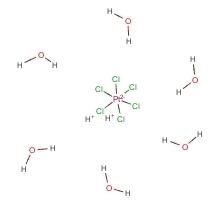Formula H2PtCl6 Density 2.43 g/cm³ Appearance Reddish brown solid | Molar mass 409.81 g/mol Melting point 60 °C | |
 | ||
Make purified chloroplatinic acid
Chloroplatinic acid or hexachloroplatinic acid is an inorganic compound with the formula [H3O]2[PtCl6](H2O)x. A red solid, it is an important commercial source of platinum, usually as an aqueous solution. Although often written in shorthand as H2PtCl6, it is the hydronium (H3O+) salt of the hexachloroplatinate anion (PtCl2−
6). The compound is also available as the hexahydrate.
Contents
- Make purified chloroplatinic acid
- Production
- Reactions
- Potassium determination
- Purification of platinum
- Catalysis
- Related compounds
- References
Production
Chloroplatinic acid is produced by dissolving platinum metal sponge in aqua regia. Brownish red crystals can be isolated by evaporating this solution to a syrup.
Pt + 4 HNO3 + 6 HCl → "H2PtCl6" + 4 NO2 + 4 H2OA related procedure gives the hexahydrate, H2PtCl6(H2O)6.
Alternative methods have been heavily investigated, but the older literature can be unreliable.
Reactions
When heated, hexachloroplatinic acid decomposes first to platinum(IV) chloride, and for this reason heating of hexachloroplatinic acid can result in insoluble platinum compounds.
(H3O)2PtCl6·nH2O → PtCl4 + 2 HCl + (n + 2) H2OPotassium determination
Chloroplatinic acid was popularized for the determination of potassium. The potassium is selectively precipitated as potassium chloroplatinate. Determinations were done in 85% (v/v) alcohol solutions with excess platinate ions, and the precipitated product was weighed. Potassium could be detected for solutions as dilute as 0.02 to 0.2% (m/v).
This method for determination of potassium was advantageous vs. the sodium cobaltinitrite method used previously, since it required a single precipitation reaction. Today, the concentration of potassium is determined with an ion-selective electrode. These modern methods remain subject to interference.
Purification of platinum
Treatment with an ammonium salt, such as ammonium chloride, precipitates solid ammonium hexachloroplatinate,. Heating the ammonium salt in hydrogen reduces it to elemental platinum. Platinum is often isolated from ores or recycled from residues thus.
Catalysis
Like many platinum compounds, chloroplatinic acid is used in catalysis. This compound was first reported by John Speier and colleagues from Dow Corning Corporation to catalyze the addition of silyl hydrides to olefins, hydrosilylation. Early test reactions used isopropanol solutions of trichlorosilane (SiHCl3) with pentenes. Prior work on the addition of silanes to alkenes required radical reactions that were inefficient. As well as with Karstedt's catalyst, Speier's catalyst enjoys widespread use for hydrosilylation, the main drawback is that the deliquescent properties of the catalyst.
It is generally agreed that chloroplatinic acid is a precursor to the actual catalyst. A possible role for colloidal platinum or zero-valent complexes has also been considered.
Related compounds
Chloroplatinic acid prepared from aqua regia is occasionally contaminated with nitrosonium hexachloroplatinate, (NO)2PtCl6. This species is obtained by the reaction of nitrosyl chloride (NOCl) and platinum metal.
